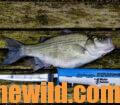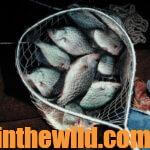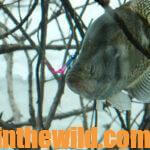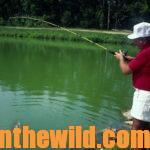Editor’s Note: Don’t bet on the crappie spawn in March, particularly if a cold front hits. Don’t spend your money or your vacation time on a fishing trip during March, expecting to find crappie spawning in shallow water. Although crappie usually spawn then, you may not locate them actively spawning and/or feeding in shallow water on the spring day you fish. I’ve learned strategies that help me take crappie almost every time I fish in the spring, and I always bet against the spawn. Let’s look at some ways to catch spawning crappie when they’re not holding in shallow water to lay their eggs.
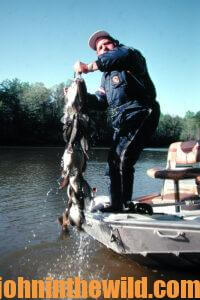 The crappie had held on the bank, and anglers had loaded their coolers the week before I arrived one spring at Alabama’s Lake Martin where I planned to fish some years ago. But unfortunately, the temperatures dropped from 75 to 32 degrees on the March morning I fished. Alabama had experienced one of those crazy, winter-like freezes that only seemed to occur when I decided to fish for spring crappie.
The crappie had held on the bank, and anglers had loaded their coolers the week before I arrived one spring at Alabama’s Lake Martin where I planned to fish some years ago. But unfortunately, the temperatures dropped from 75 to 32 degrees on the March morning I fished. Alabama had experienced one of those crazy, winter-like freezes that only seemed to occur when I decided to fish for spring crappie.
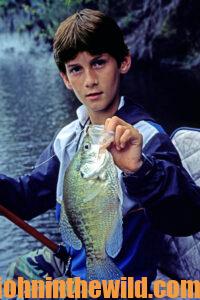 “We’ll still catch some crappie today,” my fishing buddy that day, the late John Powell, of Montgomery, Alabama, one of the first pro bass fishermen on the B.A.S.S. circuit, told me. For almost two decades, Powell earned a living as a professional bass fisherman but loved to catch and eat crappie. “The fishing looks awful for the day,” I said to Powell. Powell grinned and replied, “Yeah, but I know where the cold front has put the crappie.” Powell then moved the corks on his poles to about 6-1/2 feet deep. “Get in my boat, and we’ll catch some fish,” Powell told me.
“We’ll still catch some crappie today,” my fishing buddy that day, the late John Powell, of Montgomery, Alabama, one of the first pro bass fishermen on the B.A.S.S. circuit, told me. For almost two decades, Powell earned a living as a professional bass fisherman but loved to catch and eat crappie. “The fishing looks awful for the day,” I said to Powell. Powell grinned and replied, “Yeah, but I know where the cold front has put the crappie.” Powell then moved the corks on his poles to about 6-1/2 feet deep. “Get in my boat, and we’ll catch some fish,” Powell told me.
When we had moved 15-yards away from the bank, Powell stopped his big boat motor, put his trolling motor into the water, baited his line with minnows and fished the open water. “Does an underwater brush top or a stump row lie below this surface?” I asked Powell. “Nope,” he said. “Look at the depth finder.” When I only saw flat bottom on the depth finder, I told Powell that I didn’t understand why we were fishing in the open water where crappie had no place or reason to concentrate. Powell’s cork sank. He pulled a 1-1/2 pound crappie over the side of the boat.
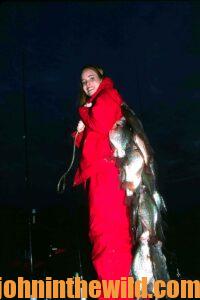 “We’re fishing in this spot because crappie are here,” Powell explained with a big smile, as he baited another minnow and swung his cork over the open water. Before Powell’s cork could float upright, it sank beneath the surface. Another big slab took the bait. At the same time, my cork sank, and I felt pressure on my pole.
“We’re fishing in this spot because crappie are here,” Powell explained with a big smile, as he baited another minnow and swung his cork over the open water. Before Powell’s cork could float upright, it sank beneath the surface. Another big slab took the bait. At the same time, my cork sank, and I felt pressure on my pole.
 “When a cold front hits a lake in the spring, crappie on the bank move into 6 to 12 feet of water, depending on the severity of the front and the length of time it remains on the lake,” Powell reported. “These spawning fish will hold on any type of structure they find on the bottom – a stump, a limb, a Coke bottle or a big rock. Crappie seem to know a fast-moving cold front won’t last long. They don’t move too far away from their intended spawning grounds and don’t need much cover on which to hold. Crappie don’t hold on structure to feed during the spawn, unlike any other time of the year. They want to remain in warm water until they can return to spawn in the shallows.”
“When a cold front hits a lake in the spring, crappie on the bank move into 6 to 12 feet of water, depending on the severity of the front and the length of time it remains on the lake,” Powell reported. “These spawning fish will hold on any type of structure they find on the bottom – a stump, a limb, a Coke bottle or a big rock. Crappie seem to know a fast-moving cold front won’t last long. They don’t move too far away from their intended spawning grounds and don’t need much cover on which to hold. Crappie don’t hold on structure to feed during the spawn, unlike any other time of the year. They want to remain in warm water until they can return to spawn in the shallows.”
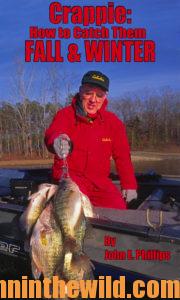 To learn more about crappie fishing in the fall and winter, check out John E. Phillips’ book, “Crappie: How to Catch Them Fall & Winter,” available in Kindle, print and Audible at https://www.amazon.com/gp/product/B00GDP0W2C/ref=dbs_a_def_rwt_hsch_vapi_taft_p1_i3.
To learn more about crappie fishing in the fall and winter, check out John E. Phillips’ book, “Crappie: How to Catch Them Fall & Winter,” available in Kindle, print and Audible at https://www.amazon.com/gp/product/B00GDP0W2C/ref=dbs_a_def_rwt_hsch_vapi_taft_p1_i3.
You may have to copy and paste this link into your browser. (When you click on the book, notice on the left where Amazon says you can read and hear 10% of the book for free). On the right side of the page and below the offer for a free Audible trial, you can click on Buy the Audible book.
Tomorrow: Bushwhack Crappie in the Spring

